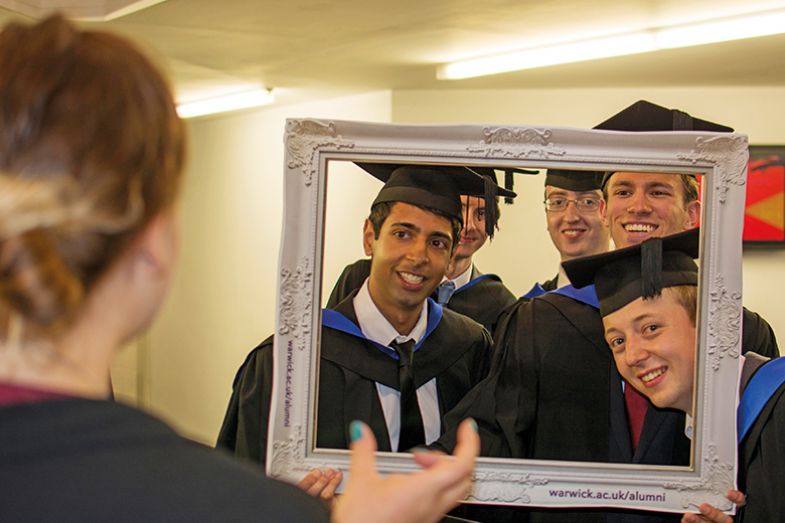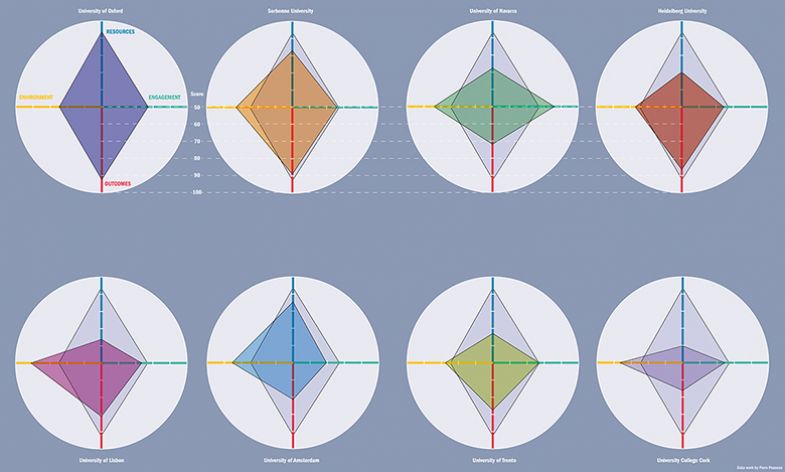Browse the full Times Higher Education Europe Teaching Rankings 2018 results
The University of Oxford has topped a new Times Higher Education pilot ranking of European universities that focuses on institutions’ teaching and learning environments.
As well as receiving the top overall score, the UK institution is number one in the outcomes pillar, which draws on data on teaching reputation, graduation rate and the development of students’ skills.
It is followed in second place by the University of Cambridge, which is number one in the resources pillar. This looks at universities’ staff-to-student ratio, research productivity and quality of services.
However, while these international research powerhouses top the table, the student-focused nature of the pilot THE Europe Teaching Rankings means that overall the results differ significantly from the research-focused THE World University Rankings.
In particular, some less well-known universities perform well on the student engagement pillar, which is based on the results of THE’s first European Student Survey – a student engagement survey of more than 30,000 university students, which includes questions on whether teaching supports critical thinking, whether classes challenge students and whether students have the opportunity to interact with staff.
– Sharp learning curves
– Our information expedition
– Developing continental standards
– Teaching and research – both alike in dignity
– Prestigious European universities have ‘worst gender balance’
Overall, half of universities’ overall scores in the ranking, which includes more than 240 universities across eight countries, are based on the results of the survey.
Spain’s University of Navarra, which is in the 301-350 band in the World University Rankings, takes eighth place overall in the Europe list, thanks to a strong score on the engagement pillar. It received particularly high scores for survey questions on student career preparation, students’ access to learning materials and the quality of the learning environment (such as lecture halls and study areas).
Another Spanish institution, Comillas Pontifical University, is in the 51-75 band overall in the Europe ranking, but tops the engagement pillar.
Meanwhile, Hanze University of Applied Sciences in the Netherlands (151-200 overall) is ranked first on the environment pillar, which measures the gender balance of staff and students.
The Europe Teaching Rankings is part of THE’s series of tables focusing on institutions’ teaching and learning environments. The pilot 2018 table is underpinned by 13 individual performance metrics and focuses on western and southern Europe only.
Overall, eight countries feature in the ranking: UK, Spain, Germany, Italy, France, the Netherlands, Portugal and the Republic of Ireland.
We’re in the pilot phase of this ranking and calling on universities and governments to get involved to make the data set even richer. To get involved or share your views, please email: europerankings@timeshighereducation.com
Europe Teaching Rankings 2018: Top 10
|
Position in Europe Teaching Rankings 2018 |
Position in World |
Institution |
Country |
|
1 |
1 |
United Kingdom |
|
|
2 |
2 |
United Kingdom |
|
|
3 |
NR |
France |
|
|
4 |
91 |
United Kingdom |
|
|
5 |
16 |
UCL |
United Kingdom |
|
6 |
76 |
United Kingdom |
|
|
7 |
=54 |
United Kingdom |
|
|
8 |
301–350 |
Spain |
|
|
=9 |
=175 |
United Kingdom |
|
|
=9 |
=137 |
United Kingdom |
 Source: Getty
Source: Getty

A class apart
Our inaugural rankings allows some less familiar names to shine, highlighting their success in both challenging and satisfying their students
If you were asked to name the top research universities in Europe, it is likely that several names could easily come to mind.
Asked to name the top teaching universities in the continent, however, and you might have to think a bit longer and harder before replying. While the UK’s teaching excellence framework might provide some guidance in judging the country’s leading teaching universities (depending on your opinion of the metrics it employs), there has been little research to date measuring the quality of teaching across the whole of Europe.
The Times Higher Education Europe Teaching Rankings seek to change that, and the results of our 2018 pilot suggest that while some famous research powerhouses excel on teaching, many less familiar institutions are providing the best learning environments for students.
Just eight countries are represented in the table, and some notable universities are absent – we employ strict eligibility criteria to ensure that the data used are valid and comparable across national systems (see methodology, pages 28-29). Some universities also chose not to participate in this pilot ranking.
But there are also lots of newcomers to the THE database: more than a quarter of places in the table (62, or 26 per cent) are filled by universities that did not feature in the research-focused THE World University Rankings 2018 (which includes 1,103 institutions).
View this year's Europe Teaching Rankings methodology in full
The UK is the most prominent country in the Europe Teaching Rankings, claiming 100 of the 242 places. Although this predominance is in part a reflection of the availability of the country’s university data, the UK undoubtedly puts in a strong performance. Its oldest and most prestigious institutions – the universities of Oxford and Cambridge – claim the top two places in the ranking, and 13 other UK institutions find a place within the top 20.
Spain is the next-most-represented nation, with 42 institutions, interestingly led by the University of Navarra at eighth place. The private Pamplona-based university, which sits in the 301-350 band in the THE World University Rankings, outperformed many of the country’s more well-known public institutions, including Pompeu Fabra University, the Autonomous University of Barcelona and the University of Barcelona.
Germany is next in the country roll call, occupying 31 places, with its representatives led by the nation’s oldest higher education institution, Heidelberg University, at joint 26th place. Italy and France are close behind, with 25 and 23 representatives, respectively, while the Netherlands (which punches below its weight in this table when compared with its research strength) and Portugal each take eight places. The Republic of Ireland lays claim to five places.
Many of the less well-known entrants in the table become more prominent when the list is filtered to examine specific areas of teaching excellence.
Spain’s Comillas Pontifical University, for example, is ranked in the 51-75 band overall but is number one in the engagement pillar, which is based on the results of nine questions in THE’s first European Student Survey.
The private Catholic university achieves the highest average score in two of these questions: providing opportunities for collaborative learning and providing opportunities for students to learn about and make connection to the world of work.
It is also the top performer when it comes to supporting students to learn skills that will be useful in the world of work after university – a question that forms one of the metrics in the outcomes pillar.
Students’ comments in the survey testify to the high regard they have for their experience at Comillas Pontifical University.
One student at the institution says: “I like the personal attention that the professors offer us [and] the professional attitude that they demand of us.”
Another says: “I appreciate the quality of the facilities, as well as the extracurricular activity offered and the global and international vision that they teach us.”
Antonio Obregón, vice-chancellor of the Madrid institution, says that teaching at the university is heavily focused on “teamwork” and learning “outside the classroom”. He also notes that students are well represented on the institution’s governing boards and are surveyed regularly to suggest improvements.
The result, says Obregón, is that just 6.7 per cent of students drop out during their course.
Search our database for the latest university jobs in Europe
The rest of the top 10 for engagement is made up of a variety of institutions, from science-focused universities, such as Italy’s Marche Polytechnic University, to research-intensives, such as Imperial College London, to those known nationally for their strong student experience, such as the UK’s Loughborough University.
The environment pillar also shines a spotlight on some less well known institutions. Hanze University of Applied Sciences in the Netherlands is in the 151-200 band overall, but it tops this pillar, which is the first in a THE ranking to measure universities’ student and staff gender balance. The Amsterdam University of Applied Sciences is second on this measure (201+ overall), and third is the Republic of Ireland’s University of Limerick (76-100).
Marie Connolly, Limerick’s head of equality and diversity, says that Ireland’s university admissions system does not allow institutions to choose their students – undergraduates are automatically allocated a place at their university of choice if they achieve the suitable grades.
However, she says, individual departments at Limerick have used outreach programmes to attract under-represented groups to their courses – for example, by working with girls’ schools to recruit more young women in science, technology, engineering and mathematics disciplines.
Departments also run focus groups with students to gather feedback on their experience in the classroom, on unconscious bias from staff or peers, and on how learning strategies could better cater to different types of students.
Connolly says that the Athena SWAN gender equality accreditation has been a useful benchmark for the university’s work in this area and has engaged “our academic staff to think about how inclusive their teaching is”.
But given that Irish universities must achieve this recognition by the end of 2019 to continue to be eligible for funding from the Science Foundation Ireland, the Irish Research Council and the Health Research Board, it is perhaps surprising that more of the country’s universities are not excelling in this area. The next best Irish university for environment is University College Cork, which only just makes the top third when ranked on the environment pillar alone.
Limerick is also a strong performer when it comes to preparing students for careers, ranking third on the engagement survey metric measuring universities’ effectiveness in helping students to secure valuable internships.
Patrice Twomey, director of the cooperative education and careers division at Limerick, says that 2,000 of its students across 56 degree programmes undertake a six- to eight-month placement each year “as a formal, academically accredited compulsory element of their degree programme”. About a fifth of these placements are with an international company.
All students, regardless of their discipline, academic performance or skills profile, are eligible for the programme, she adds.
“That is quite unusual,” Twomey says. “You would have a lot of universities maybe cherry-picking by course or by high-performing students, but this is a very inclusive programme.”
She adds that research shows that students who have “had to flip between the world of classroom and the world of work” benefit from what is known as “career crystallisation – they have much more career clarity when they come back [from their placement] and [therefore] they are much easier to teach”.
“The opportunity to dip your toe into the world of work in that way is so confidence-building, so skills-building; and it helps them immensely in seeing the relevance of what they’re studying – whatever that may be,” she says.
But Twomey adds that the programme is about much more than helping students to secure their first position after graduation.
“We would really see it as an opportunity for them to develop knowledge and understanding that would make it more likely for them to be successful in their future career, as opposed to their first job,” she says.
Browse Times Higher Education’s full portfolio of university rankings
Many research-intensive universities perform very strongly on the resources and outcomes pillars in the ranking. The former is headed by seven UK Russell Group institutions, which are among the most well-funded universities in Europe. The top of the outcomes pillar features a broader range of nations, including Germany’s Technical University of Munich and LMU Munich, France’s Sorbonne University, and the UK’s University of Oxford, Imperial College London and UCL.
But research-intensive universities score relatively poorly on environment. Imperial is ranked joint 11th in the teaching rankings and eighth in the World University Rankings, but is in the bottom 5 per cent for environment. Indeed, just four universities that are in the overall top 20 in the teaching ranking make the top 100 in the environment pillar.
The trend is less pronounced when it comes to engagement, but several notable institutions languish on this pillar, too. UCL, for instance, ranks fifth overall in the teaching rankings and 16th in the World University Rankings but is in the top 30 per cent for engagement. Germany’s top research university, LMU Munich, is in the top 45 per cent for engagement.

There are, however, some notable exceptions.
Take Germany’s University of Göttingen. It is ranked 38th overall in the teaching rankings, in the top 10 per cent in the engagement pillar and top in the engagement metric that measures students’ willingness to recommend their institution to a friend or family member.
Andrea Bührmann, the institution’s vice-president for teaching, learning and equal opportunities, says that Göttingen expanded its teaching and learning strategy after winning competitive teaching funding from the German government.
The university now promotes the “triple helix” of teaching – “digitisation, internationalisation and diversity orientation” – with the overall aim of further enhancing its research-oriented teaching, she says.
From this have come a number of significant changes at Göttingen.
Many courses are now based on a blended learning approach, which mixes online and face-to-face teaching. Classes have a greater emphasis on students using research and data. Students and academics work in diverse teams with people from different backgrounds and disciplines, and there is a strong focus on internationalising curricula. The central idea is to empower students to become globally concerned citizens.
Another strong research institution that outperforms many of its research peers is the University of Warwick. It is fourth overall in the teaching rankings and makes the top 20 in the resources, engagement and outcomes pillars.
Chris Hughes, pro vice-chancellor for education at Warwick, says that there are special benefits of studying in a research-intensive university.
Students are “taught by researchers who are active and at the top of their field”, and they have a chance to “work alongside academics to do research”, he says.
In the student survey, Warwick is ranked 15th for providing students with opportunities for social engagement (such as joining student societies, organising activities on campus and interacting with people in different courses or from different backgrounds) – a question that is not used as a metric in the ranking but demonstrates the quality of Warwick’s student experience.
Hughes says that there is “a lot of pressure on universities to deliver an excellent education, and there is a tendency sometimes for universities or students to slip into a consumerist type of relationship”, but “that’s one of the things we’re really desperate to avoid at Warwick”.
Instead, the university seeks to “co-produce” the student/institution relationship, he says, by ensuring that students are well represented on governance teams and have a say in improving their educational experience.
“Obviously they want excellent provision of education, and they want value for money. But what they really want is an education that does stretch them, that they have a voice in shaping and that they can shape to their own needs…That’s the kind of value that we really want to preserve in the university.”
Standout performers
How the top institutions in each country score on each of the four pillars of assessment
These eight “spider” charts show how the top university in each country covered by the Times Higher Education Europe Teaching Rankings performs across the four “pillars” that contribute to the final score.
A look at the University of Oxford’s chart (which is also shown for comparison in the others) demonstrates that its position as the highest-ranked university – matching its placing in the research-led THE World University Rankings – owes much to its outcomes and resources, elements arguably boosted by its elite research status.
But other countries’ top institutions are not always those that excel in the World University Rankings, evidence that other factors can drive teaching excellence.
For instance, the University of Navarra – which sits in the 301-350 band in the 2018 World University Rankings – comes eighth in the Europe teaching list, largely because of a very strong performance in the engagement pillar, which makes up 40 per cent of the final score and is driven by students’ own views of an institution.
The data also show how many institutions make up for relatively low scores in the resources or outcomes pillar with a more diverse campus environment, which counts towards 20 per cent of the final outcome. Examples here include the University of Lisbon, the University of Amsterdam and University College Cork.
Simon Baker





